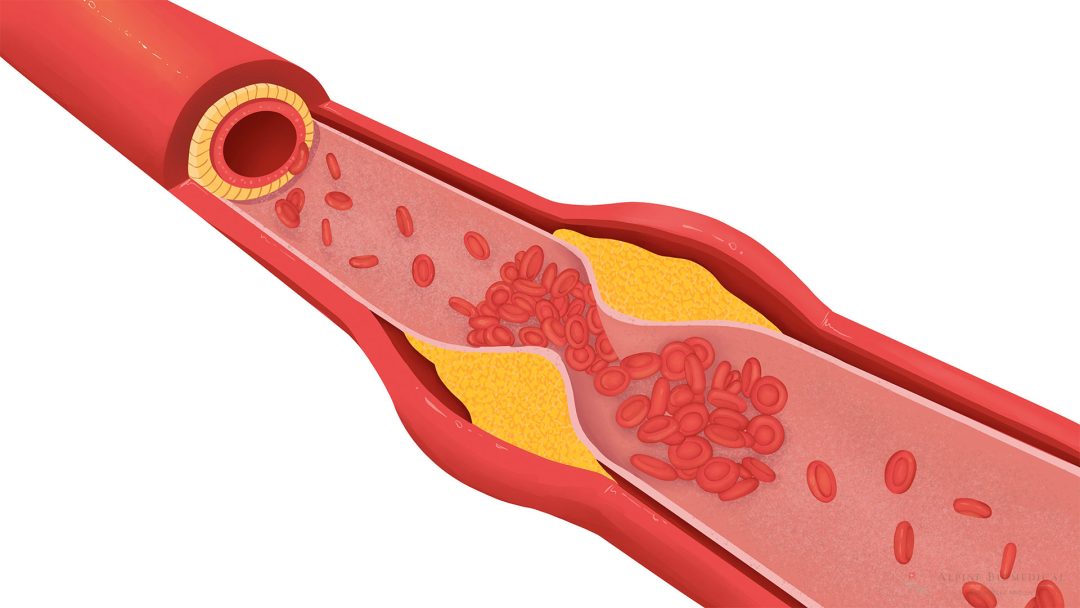Arteriosclerosis

Arteriosclerosis, also known as hardening of the arteries, is a progressive disease of the arteries in which plaque (deposits of fats, proteins and calcium) accumulates in the vessel walls. This leads to narrowing and hardening of the arteries, which can impair blood flow or, in the worst case, detach and block smaller vessels. Until a plaque detaches, the disease is asymptomatic. However, if a vessel, such as the coronary arteries, becomes blocked, the classic symptoms of a heart attack occur and rapid action is essential.
Localization of Arteriosclerosis
Arteriosclerosis can develop in all parts of the circulatory system, although arteries are predominantly affected. Veins practically never show arteriosclerotic changes in the vessel walls.
Arteriosclerosis is particularly common in the large arteries, especially where there is an anatomical branching of the vessels. Carotid arteries, inguinal arteries and coronary arteries are therefore more susceptible to arteriosclerosis and show increased plaque deposits. However, arteriosclerosis also develops more frequently in the aorta (main artery) due to the high pressures.
Symptoms of Arteriosclerosis
Arteriosclerosis shows no real symptoms and only becomes noticeable in the late stages.If the vessels are severely narrowed or if a thrombus forms, this can lead to sudden, life-threatening conditions.
Symptoms associated with arteriosclerosis are:
- Tightness and pain in the chest when the coronary arteries are affected (coronary artery disease)
- Circulatory disorder of the brain and symptoms of a stroke
- Symptoms of PAD when the leg arteries are affected
Causes of Arteriosclerosis
There are many causes of arteriosclerosis. These can reinforce each other and ensure that plaque builds up in the vessels over the years. The following causes of arteriosclerosis are listed:
- Unhealthy eating habits
- Smoking
- High blood pressure
- Diabetes
- Overweight and obesity
- Lack of exercise
- Environmental pollution and poisoning of the body, e.g. mercury
- Intestinal health (intestinal milieu and leaky gut)
- Unhealthy fat levels (hypercholesterolemia)
- Genetic factors
Arteriosclerosis Therapy
The therapy should, as far as possible, address the cause of the arteriosclerosis. Preventive measures are also effective and should be integrated.
The treatment of arteriosclerosis includes:
- Lifestyle changes such as a healthy diet, stopping smoking, regular physical activity.
- If necessary, medication to lower cholesterol
- If necessary, medication to lower blood pressure and thin the blood
- In advanced cases of arteriosclerosis, vascular surgery may be necessary to treat narrowed or blocked arteries.
Holistic, integrative medicine also aims to optimize intestinal health and the body’s detoxification functions. Various detoxing procedures such as intestinal cleansing, phytotherapy, chelation therapy or INUSpheresis (a special blood purification) are used for this purpose. In addition, certain dietary supplements such as omega-3 fatty acids, coenzyme Q10, vitamin D and vitamin K2 can have a supportive effect by promoting heart health and reducing inflammation in the body. Stress management and relaxation techniques such as meditation, yoga or breathing exercises also play an important role in lowering stress levels and improving overall well-being. In addition, traditional herbal remedies such as garlic, ginger, ginkgo biloba and cayenne pepper are often used to support heart health and can be considered alternative therapies for atherosclerosis.
Early detection and prevention are critical to slowing the progression of atherosclerosis and minimizing the risk of heart attacks, strokes and other serious complications.
Med. pract. Dana Hreus M.A.
In the case of arteriosclerosis, close, interdisciplinary cooperation with experienced therapists from different medical specialties can be useful.

Further information
The information listed contains relevant topics and serves to improve understanding.